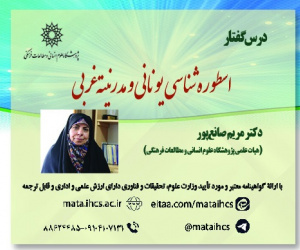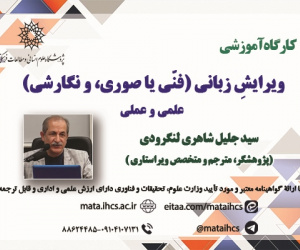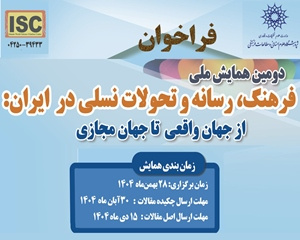تحلیل همبستگی کانونی رابطه بین عوامل موثر بر تاب آوری در مواجهه با خشک سالی، مطالعه موردی: روستاهای شهرستان کنگاور (مقاله علمی وزارت علوم)
درجه علمی: نشریه علمی (وزارت علوم)
آرشیو
چکیده
با توجه به روند روزافزون بلایای طبیعی، در صورت ترکیب رویکرد تاب آوری با چرخه مدیریت بلایا می توان به رویکرد جامعی برای مدیریت خشک سالی دست یافت. ازآنجایی که ظرفیت های موجود نقشی متفاوت در این فرایند ایفا می کنند، در این تحقیق به دنبال آن هستیم تا میزان تأثیر عوامل بر وضعیت تاب آوری بر اساس رویکرد سرمایه های اجتماعی موردبررسی قرار گیرد. این پژوهش با هدف کاربردی –توسعه ای، در قالب مطالعه اسنادی (کتابخانه ای) و پیمایشی از نوع همبستگی کانونی انجام گرفته است. با توجه به اینکه هدف از تحقیق بررسی وضعیت تاب آوری جامعه بر اساس متغیرهای مستقل «سرمایه های اجتماع» می باشد، از روش تحلیل همبستگی کانونی برای بررسی رابطه بین مجموعه یا ابعاد سرمایه های اجتماع با مجموعه یا ابعاد چرخه مدیریت بلایا با استفاده از نرم افزار spss22 استفاده گردید. حجم نمونه برآورد شده بر اساس فرمول کوکران، 494 و با روش نمونه گیری خوشه ای چندمرحله ای و تصادفی نفر برآورد گردید. داده های موردنظر با استفاده از پرسشنامه جمع آوری گردید. بررسی پایایی داده های به دست آمده نشان از تأیید پایایی در سطح عالی (91/0) بود. نتایج به دست آمده از تحلیل کانونی نشان داد کانون اول با مقدار ویژه 92/0 بیشترین توضیح را درباره مدل می دهد، مقدار ضریب تعیین 48/0 محاسبه شده کانون اول نشان می دهد که 48 درصد از واریانس کل جامعه توسط آن تبیین می شود. کانون های دوم و سوم نیز به ترتیب حدود 7 و 1 درصد از تغییرات مدل را توضیح می دهد. همچنین در مرحله آمادگی، سرمایه انسانی، بیشترین اثربخشی با ضریب کانونی 25/0 دارد، به ترتیب سرمایه مالی، سیاسی و فرهنگی و نهایتاً سرمایه اجتماعی و طبیعی و فیزیکی که معنادار نمی باشند. همچنین در مرحله کاهش سرمایه مالی بیشترین تأثیرگذاری را در تاب آور سازی جامعه با ضریب کانونی 28/0 بر عهده دارد. در مرحله بازیابی نیز که ناظر بر دوره پس از خشک سالی می باشد، سرمایه فرهنگی بیشترین نقش را با ضریب کانونی 21/0 ایفا می کند.Focal Correlation Analysis of the Relationship between Factors Affecting Resilience in the Face of Drought The Case Study of Villages of Kangavar City
It seems that by introducing the resilience approach to the activities of the disaster management cycle, a comprehensive approach to drought management can be achieved. In this regard, the intended research seeks to explain the process relationships of disaster management, emphasizing the resilience approach based on community capital. This research has been conducted in the form of a focal correlation survey. The focal correlation analysis method was used to investigate the relationship between the set or dimensions of community capital with the set or dimensions of the disaster management cycle using spss22 software. Based on Cochran's formula, the sample size was 494 rural residents randomly selected by the multi-stage cluster sampling method. The results obtained from the research showed that out of the 3 centers identified, the first one with an eigenvalue of 0.92 explains the most about the model; the value of the coefficient of determination calculated at 0.48 indicates that 48% of the total variance of the community is accounted for by the center. Human capital is the most effective factor in the preparation stage. In the stage of financial capital reduction, it has the most impact on the resilience of society. In the recovery phase, which refers to the post-drought period, the findings showed that cultural capital plays the most important role.
Extended Abstract
Introduction
One of the most traumatic disasters is drought, resulting from climate change and human activities, which has affected Kangavar city, especially rural areas. In a way, that has made Kangavar villages face a more serious crisis in recent years. To the extent that it has led to a decrease in production and an increase in costs, unemployment and a decrease in income sources. In this regard, knowledge of the capacities and bottlenecks of the discussed rural areas and their analysis becomes very important in facing drought. In this regard, a new approach called resilience is proposed, in which the important issue is to pay attention to the talents and capabilities of the local community. Since the crisis management approach emphasizes actions based on government interventions after the event, it seems that the local capacities to face the crisis are being ignored. Based on this, the intended research seeks to analyze the process relationships of disaster management with an emphasis on the resilience approach based on community capital in an integrated manner. This is because management, based on existing capacities, considers residents and the local community as the axis of planning in the management process.
It seems that by introducing the resilience approach to the activities of the disaster management cycle, a comprehensive approach to drought management can be achieved, in which the adverse effects of drought can be minimized by using the capacities of the rural community. Also, this approach emphasizes capacities, participation, empowerment, and learning of the rural community to deal with disasters.
Methodology
The present research is practical-developmental and documentary (library)-survey (descriptive-analytical) in terms of goal and research implementation, respectively. According to the nature of the data, it is a quantitative research type. The method of collecting data and information
is both library and field. The estimated sample size based on Cochran's formula was 494 rural residents with an emphasis on household heads, which were identified by multi-stage cluster sampling method. In the next stage, people were selected from among the selected villages. Randomly selected and finally, the questionnaire was distributed among people. In order to analyze the obtained data, the basic or focal correlation method was used. Focal correlation analysis allows the discovery of complex relationships between independent and dependent variables considering the shortcomings of research in the field of drought and resilience in an integrated manner.
Results and discussion
The analysis of the data obtained from the questionnaire showed that human capital is the most effective in the preparation stage, followed by financial, political, and cultural capital, and finally, social, natural, and physical capital, which are not significant. Since people's decision-making in facing critical situations is based on their perception of risk. One of the important factors in promoting resilience is a rational understanding of the current situation. In the stage of financial capital reduction, it has the most impact on the resilience of society. Considering that resilience in new approaches is the capacity to respond to change in an adaptive manner, instead of returning to the stage before the crisis, it seeks transformation and change to a newer state that is more stable in the current situation. Therefore, access to relatively sufficient financial resources has provided enough motivation to enter a newer and more favorable path. The findings also showed that people with relatively favorable financial capital and receiving bank facilities had replaced the traditional irrigation methods with the optimal irrigation methods, which has emerged as the most important measure in reducing the effect of drought. Also, the change in the common cultivation patterns has increased significantly among the villagers. Cultural capital plays the most important role in the recovery phase, which refers to the post-
drought period. Considering that cultural capital is a representation of non-economic forces such as family background, values, beliefs, social class, formal education, commitments to education, etc., based on the type of people's vision, people's tendencies, individual and social behavior, and manners are used to regulate interactions with the surrounding environment and provide the ground for mobilizing community resources and collective action to ultimately lead to a compatible dealing with risks through physical and mental resistance in order to achieve acceptable levels of functioning. The findings showed that the cultural and political capital could also provide the basis for improving the level of awareness and knowledge regarding the upcoming phenomena, considering the strengthening of vertical communication between people and rural management institutions, as well as holding training classes.
Conclusion
The findings of the research showed that the resilience approach has the necessary capacity to be combined with the disaster management approach. That is, by introducing the resilience approach to the activities of the disaster management cycle, a comprehensive approach to drought management can be achieved, in which the adverse effects of drought can be minimized by using the capacities of the rural community. Also, this approach emphasizes capacities, participation, empowerment, and learning of the rural community to deal with disasters. By emphasizing both stages in disaster management and combining them with the resilience approach, a comprehensive approach to dealing with disasters can be achieved.
Funding
There is no funding support.
Authors’ Contribution
All of the authors approved thecontent of the manuscript and agreed on all aspects of the work.
Conflict of Interest
Authors declared no conflict of interest.
Acknowledgments
We are grateful to all the scientific consultants of this paper.







